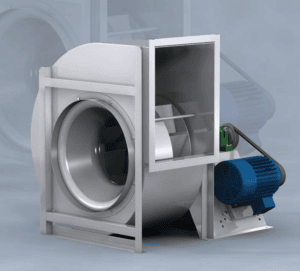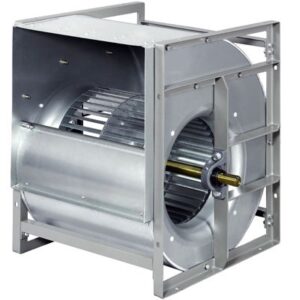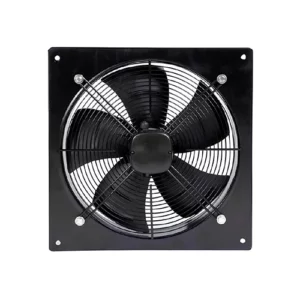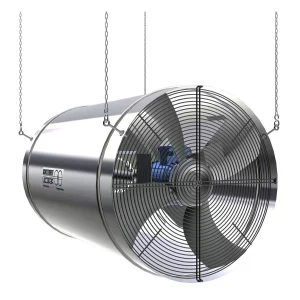industrial fan
The Industrial Fan is a powerful device designed for air circulation and ventilation in large industrial spaces. These fans are often higher-powered and larger compared to residential fans. For this reason, they are used industrial fans to cool facilities, equipment, machines, and workers in large and hot industrial environments. Different industrial fan types are often installed on ceilings, walls, or floors to distribute airflow throughout the space. Improving air quality, reducing humidity levels, improving productivity, and increasing comfort for employees working in industrial environments are among the most important advantages of installing these fans.
Types of industrial fan
The most common types of industrial fans, we can mention the following:
- Axial Fans: This type is designed to flow air parallel to the axis of the fan blade. Due to their energy efficiency and relatively low noise, these fans are a suitable option for installation in warehouses and production facilities.
- Centrifugal Fans: These fans work by creating airflow perpendicular to the axis of the fan blade. They also have different structures such as forward-curved, backward-curved, and radial-blade designs.
- Propeller Fans: The simple industrial fan design and propeller blade are the most important features of this type of fan. They are often used for cooling in industrial environments or general ventilation.
- Mixed Flow Fans: These types of global industrial fans have a combination of the characteristics of axial and centrifugal fans. In this way, they can create a balance between the volume of airflow and pressure.
- High-Temperature Fans: The main purpose of designing these fans is to use them in furnaces and foundries. They have high resistance to high-temperature changes.
Remember that choosing the type of industrial fan sale depends on several factors. Environmental conditions, space limitations, and pressure levels are the most important factors. To have good ventilation and high cooling efficiency in industrial facilities, it is very important to choose the right fan.
Industrial Fan Specification
The information and industrial fan specification, including the type of design and construction, the level of performance, and capability, help to choose the right fan. Key components of industrial fan specifications include:
- Fan Type: This feature has a direct role in the intended industrial fan use.
- Airflow Capacity: This feature aims to show the volume of air that the fan can circulate.
- Pressure Requirements: Fan pressure capabilities such as static pressure and total pressure are specified in this section.
- Fan Size and Dimensions: Details such as size, dimensions, configuration, and proper installation of the fan can be seen in this section. In the following, we will explain more about this feature.
- Motor Power and Speed: This feature provides information about motor power and fan speed. In this way, the amount of energy consumption can be determined. You can also find out about the fan’s performance. In the following, we will explain more about this feature.
- Material Construction: The type and quality of materials used in this section are presented. In general, materials such as steel, aluminum, or coatings resistant to corrosion, decay, and rust are used in the construction of fans. The quality of the construction material is directly related to the useful life of the fan.
- Efficiency and Noise Levels: This feature includes fan efficiency and noise level measurement. Consequently, this feature can be used to evaluate the energy efficiency and acoustic performance of the fan.
- Safety Features: Safety certificates are in this category.
Industrial Fan Speed
The industrial fan speed is a key parameter influencing airflow capacity, pressure performance, energy efficiency, and noise levels in industrial applications. By understanding the relationship between fan speed and these factors, users can effectively control and optimize their industrial ventilation or air circulation systems to achieve desired performance outcomes.
Industrial Fan Size
The industrial fan size is a critical factor that directly impacts its performance, airflow capacity, efficiency, and suitability for specific applications. The diameter of the fan blades is a key component of the fan size and plays a significant role in determining the airflow capacity and efficiency of the fan. These industrial fan parts also influence the fan’s ability to generate static pressure to overcome system resistance and maintain airflow in ducted systems. In addition to these, the overall dimensions of the fan housing, including the height, width, and depth, are important considerations in industrial fan sizing. The inlet and outlet sizes are crucial parameters that determine the compatibility of the fan with ductwork, ventilation systems, or other components in an industrial application.
Industrial Fan Installation
Proper industrial fan installation involves several key steps and considerations to ensure reliable operation, optimal airflow distribution, and compliance with safety standard industrial fans.
The first step in industrial fan installation is selecting the appropriate location for the fan based on the specific application requirements, airflow patterns, and accessibility for maintenance. The fan should be positioned to maximize airflow coverage, minimize obstructions, and facilitate easy access for inspection, cleaning, and repairs. Considerations such as mounting height, distance from walls or obstacles, and alignment with ductwork or ventilation openings are essential factors in determining the optimal fan placement.
The next step in industrial fan installation is connecting the fan to the power supply and control system according to manufacturer specifications and electrical codes. Wiring the fan motor, speed controls, safety switches, and other electrical components correctly is essential to prevent electrical hazards, motor damage, or malfunction. It is important to follow recommended wiring practices, use appropriate wire sizes and connectors, and verify proper grounding to ensure safe and reliable electrical connections.
Buy industrial fan
When you looking for buy industrial fan, there are several key factors like industrial fan company to consider to ensure you select the right fan for your specific needs:
- Fan Type
- Airflow Capacity
- Fan Size and Mounting
- Fan Performance
- Material and Construction
- Safety Features
- Maintenance Requirements
- Industrial Fan Manufacturer Reputation
- Price of Industrial Fan
Industrial Fan Price
Industrial Fans come in a wide range of prices depending on factors such as fan type and size, airflow capacity, performance features, materials and construction, brand reputation, industrial fan suppliers, and distributors of industrial fans such as the reliable SahandHavasaz company.
Also, installation and maintenance of industrial fan cost, industrial fan factory, comparative analysis, certification, additional features, and accessories, or customization options are included in the industrial fan price.
As we mentioned , industrial fans play an important role in maintaining optimal working conditions in industrial environments by providing powerful and efficient air circulation, so their reliability and performance make them essential equipment to ensure the safety and well-being of workers and also improve It transforms the overall efficiency of industrial operations.
industrial fan company
SehandHavasaz, as an industrial fan company, is ready to sell all kinds of industrial fans in retail and wholesale. To place an order or receive a consultation, you can contact the support department through the communication channels listed on the website.








